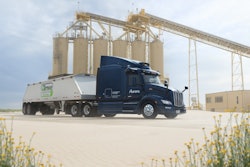For the fourth quarter ended Dec. 31, Marten Transport’s net income increased 36.6 percent to $7.1 million, up from $5.2 million for the same quarter of 2004. Operating revenue for the quarter increased 18.6 percent to $125.4 million from $105.7 million for the same quarter of 2004.
For the year ended Dec. 31, net income increased 42.9 percent to $25.1 million, up from $17.5 million for 2004. Operating revenue for 2005 increased 21.1 percent to $460.2 million from $380.0 million for 2004. Operating revenue included fuel surcharges of $19.1 million and $57.1 million for the 2005 quarter and year, compared with $10.5 million and $26.9 million for the 2004 quarter and year.
Operating revenue also included non-freight revenue principally from Marten’s logistics operations. Non-freight revenue was $5.2 million and $16.9 million for the 2005 quarter and year, compared with $2.3 million and $7.0 million for the 2004 quarter and year. Freight revenue, which excludes fuel surcharge and non-freight revenue, increased 9.0 percent to $101.2 million and 11.5 percent to $386.1 million for the 2005 quarter and year, compared with $92.9 million and $346.2 million for the 2004 quarter and year.
“Despite the challenges of high fuel prices and fierce competition for drivers, 2005 was a year of significant accomplishments,” says Randolph L. Marten, chairman and president of Mondovi, Wis.-based Marten Transport. “During 2005, we expanded our fleet of company tractors by 469 units, or 27 percent, which contributed to nearly 15 percent fleet growth and helped us overcome the attrition of owner-operators from our industry.
“Even more important, we improved the bottom line. Marten’s operating ratio improved by 110 basis points, to 90.7 percent for the year. Netting fuel surcharges against fuel expense, as many of our peers do, would have produced an operating ratio of 89.4 percent for 2005. Our margin improvement was attributable to higher rates and a continued focus on cost control and efficiency. Our ratio of tractors to nondrivers, our ratio of trailers to tractors, and the average age of our tractors and trailers all improved versus 2004.”







